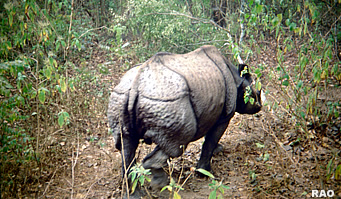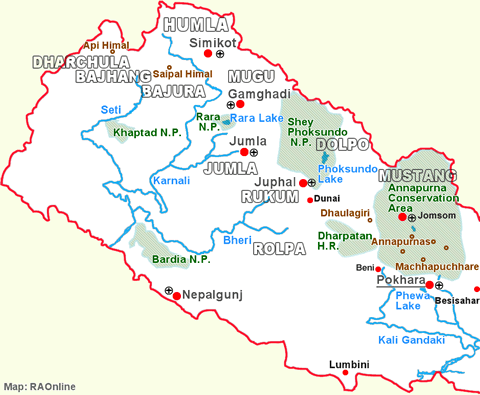 |
2014 |
|
 |
November 2014
|
Rhino successfully collared in Nepal's critical corridor |
 |
A one-horned rhinoceros was successfully collared in Khata Corridor that connects Nepal's Bardia National Park with India's Katerniaghat Wildlife Sanctuary, opening up new understandings in conservation by studying the movement and habitat use of the mega species.
 |
|
The rhino, a sub-adult female, was fitted with a satellite collar and released back into the wild.
The collaring expedition was led by the Government of Nepal's Department of National Parks and Wildlife Conservation and Department of Forests with the support of WWF Nepal, National Trust for Nature Conservation, and local communities.
Finnish Ambassador to Nepal, His Excellency Mr. Asko Luukkainen also took part in the collaring operation. |
|
"This is the first time that we have selected a corridor as a collaring site for rhinos," stated Mr. Tika Ram Adhikary, Director General of the Department of National Parks and Wildlife Conservation. "The corridors serve an important contiguous function in the Terai Arc Landscape and with the help of this study we hope to gain from useful insights in conservation that will benefit wildlife and people on both sides of the trans-boundary landscape."
 |
| Data retrieved from the satellite collar will provide key insights to habitat use and movement patterns of rhinos in the corridor.
The information generated will help to optimize the land-use pattern, land-cover configuration and habitat management within the corridor for wildlife and human use, and assess the thresholds of habitat restoration necessary to maintain a functional corridor. This will also be used in planning and designing measures to minimize potential and existing human-wildlife conflict, while ensuring permeability for rhino dispersal along the corridor. |
|
The information will provide evidence of corridor use by endangered wildlife to advocate for strategic and sustainable approaches to any infrastructure development planned inside Khata Corridor. The study will also provide information about the preferred habitat use by rhinos in the corridor allowing community based anti-poaching units to focus patrolling efforts so as to keep a closer vigil on poaching and wildlife crimes in these areas.
"It is heartening to see that Finnish support has also helped contribute to Nepal's conservation efforts," said His Excellency Mr. Asko Luukkainen. "By looking at Khata Corridor and its importance in building forest connectivity between Nepal and India, I am certain that the collaring exercise will contribute to the country's broader rhino conservation programs."
"Conservation strategies with a future outlook need the strong backing of science and informed decisions," stated Mr. Anil Manandhar, Country Representative of WWF Nepal. "The success of the collaring expedition ushers positivity for the conservation world and will enable us to work further together with the government, conservation partners and local communities in designing conservation programs that in the end promote harmony between people and wildlife."
Nepal celebrated 365 days of zero poaching of rhinos earlier this year. With an estimated 534 rhinos in the Terai Arc Landscape as per the 2011 count, the growth in rhino populations in Nepal is testimony of heightened enforcement measures and effective community conservation programs under the leadership of the government.

|
|
Chitwan
National Park
|
|
Links
|
 |
 |
 |
External
link |
| more information |
 |
|






